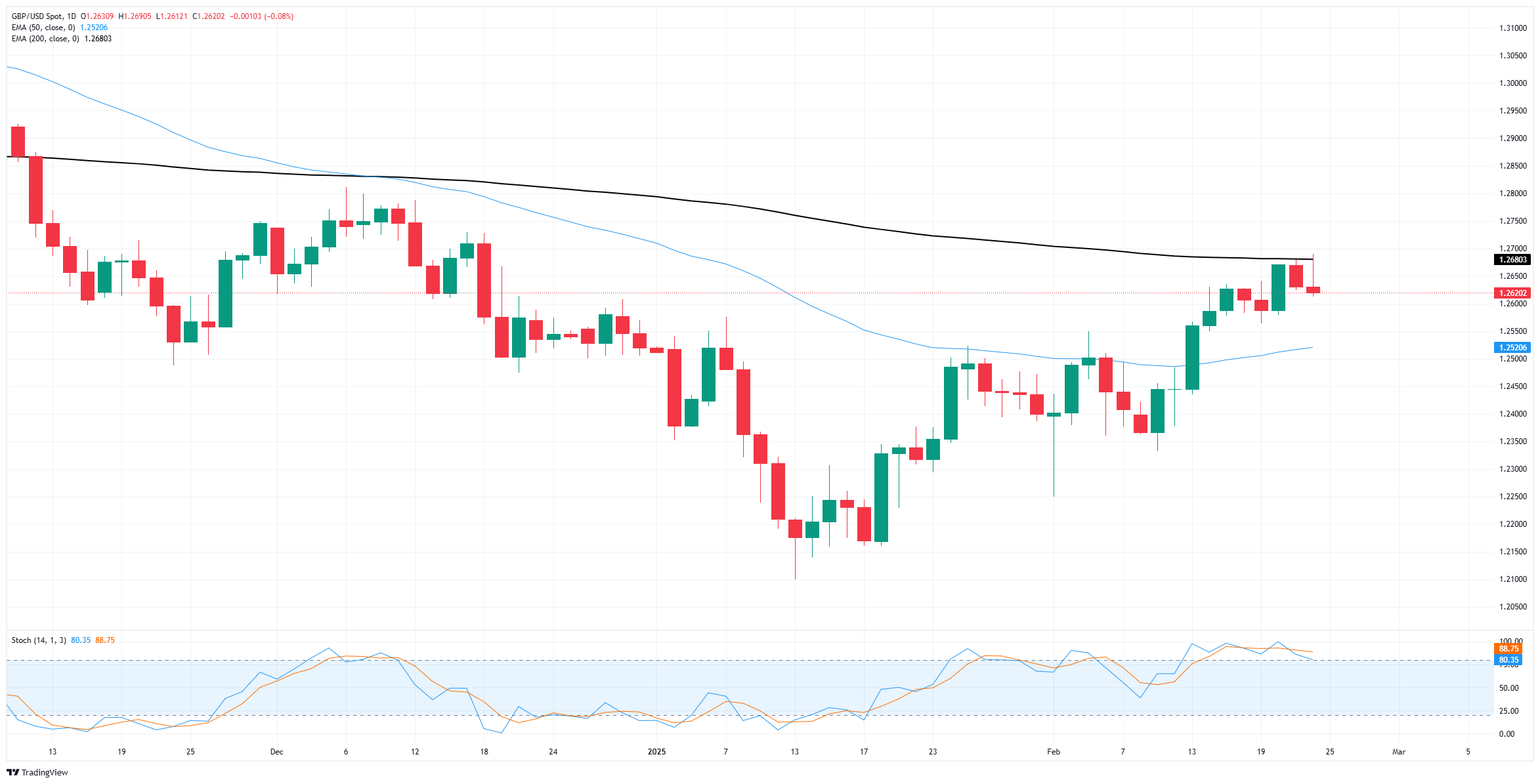Created
: 2025.02.25














![]() 2025.02.25 08:11
2025.02.25 08:11
GBP/USD churned on Monday, jumping to a fresh 10-week high before slumping back to the day's opening bids near 1.2630. Cable failed to recapture the 1.270 handle, and price action has fallen back beneath the 200-day Exponential Moving Average (EMA) near 1.2660.
A resurgence in US inflation figures late last week kicked off a fresh round of risk aversion. Investors will be focused squarely on upcoming US Personal Consumption Expenditure (PCE) inflation data due later this week. Traders hope that an early-year uptick in headline inflation data from the US will recede quickly and not solidify into another drawn-out battle with "transitory" inflation that runs too hot for the Federal Reserve (Fed) to deliver rate cuts.
Market participants hoping for an upswing in the pace of Fed rate cuts in 2025 have already been pushed to the ropes as US President Donald Trump tries to spark a global trade war, and a new surge in inflation will be the final nail in the coffin for rate cut hopes. President Trump reiterated his own threats of high tariffs on Canada and Mexico on Monday, warning that tariffs are still due to be enacted "next month" after caving on his own tariff pressures in recent weeks and granting a delay to nearly every country he's taunted with import taxes on his own citizens.
Not to be left in the dust, the Bank of England (BoE) has its own policymakers slated to make regular appearances this week, though their impact on global markets is likely to remain muted. The BoE has, thus far, largely matched market expectations on the rate cut front. The BoE's Huw Pill makes an appearance on Tuesday, followed by Swati Dinghra on Wednesday and Dave Ramsden on Friday.
With price action backing into the 200-day EMA at 1.2660, middling performance poses a significant risk to any technical trend. GBP/USD has risen around 4.4% from its last major swing low to 1.2100 in mid-January, but bidding appears to have run out of gas.
The next immediate barrier to a fresh leg down will be the 50-day EMA at 1.2520, but bidders will no doubt be waiting in the wings to kick off a new push into the high side from the 1.2500 handle.

The Pound Sterling (GBP) is the oldest currency in the world (886 AD) and the official currency of the United Kingdom. It is the fourth most traded unit for foreign exchange (FX) in the world, accounting for 12% of all transactions, averaging $630 billion a day, according to 2022 data. Its key trading pairs are GBP/USD, also known as 'Cable', which accounts for 11% of FX, GBP/JPY, or the 'Dragon' as it is known by traders (3%), and EUR/GBP (2%). The Pound Sterling is issued by the Bank of England (BoE).
The single most important factor influencing the value of the Pound Sterling is monetary policy decided by the Bank of England. The BoE bases its decisions on whether it has achieved its primary goal of "price stability" - a steady inflation rate of around 2%. Its primary tool for achieving this is the adjustment of interest rates. When inflation is too high, the BoE will try to rein it in by raising interest rates, making it more expensive for people and businesses to access credit. This is generally positive for GBP, as higher interest rates make the UK a more attractive place for global investors to park their money. When inflation falls too low it is a sign economic growth is slowing. In this scenario, the BoE will consider lowering interest rates to cheapen credit so businesses will borrow more to invest in growth-generating projects.
Data releases gauge the health of the economy and can impact the value of the Pound Sterling. Indicators such as GDP, Manufacturing and Services PMIs, and employment can all influence the direction of the GBP. A strong economy is good for Sterling. Not only does it attract more foreign investment but it may encourage the BoE to put up interest rates, which will directly strengthen GBP. Otherwise, if economic data is weak, the Pound Sterling is likely to fall.
Another significant data release for the Pound Sterling is the Trade Balance. This indicator measures the difference between what a country earns from its exports and what it spends on imports over a given period. If a country produces highly sought-after exports, its currency will benefit purely from the extra demand created from foreign buyers seeking to purchase these goods. Therefore, a positive net Trade Balance strengthens a currency and vice versa for a negative balance.
![]()
Created
: 2025.02.25
![]()
Last updated
: 2025.02.25

FXStreet is a forex information website, delivering market analysis and news articles 24/7.
It features a number of articles contributed by well-known analysts, in addition to the ones by its editorial team.
Founded in 2000 by Francesc Riverola, a Spanish economist, it has grown to become a world-renowned information website.
We hope you find this article useful. Any comments or suggestions will be greatly appreciated.
We are also looking for writers with extensive experience in forex and crypto to join us.
please contact us at [email protected].
Disclaimer:
All information and content provided on this website is provided for informational purposes only and is not intended to solicit any investment. Although all efforts are made in order to ensure that the information is correct, no guarantee is provided for the accuracy of any content on this website. Any decision made shall be the responsibility of the investor and Myforex does not take any responsibility whatsoever regarding the use of any information provided herein.
The content provided on this website belongs to Myforex and, where stated, the relevant licensors. All rights are reserved by Myforex and the relevant licensors, and no content of this website, whether in full or in part, shall be copied or displayed elsewhere without the explicit written permission of the relevant copyright holder. If you wish to use any part of the content provided on this website, please ensure that you contact Myforex.
Myforex uses cookies to improve the convenience and functionality of this website. This website may include cookies not only by us but also by third parties (advertisers, log analysts, etc.) for the purpose of tracking the activities of users. Cookie policy